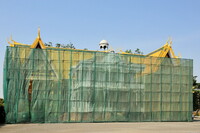| dc.coverage.spatial | Site: Phnum Pénh, Phnum Pénh (municipality), Cambodia | en_US |
| dc.coverage.temporal | begun 1865-1919 (creation) | en_US |
| dc.creator | unknown (Cambodian) | en_US |
| dc.date | 1865-1919 | en_US |
| dc.date.accessioned | 2013-09-24T17:37:10Z | |
| dc.date.available | 2013-09-24T17:37:10Z | |
| dc.date.issued | 1865-1919 | en_US |
| dc.identifier | 235109 | en_US |
| dc.identifier.other | archrefid: 2519 | en_US |
| dc.identifier.uri | http://hdl.handle.net/1721.3/142844 | |
| dc.description | Buildings shrouded for restoration (Napoleon III Pavilion at center, Damnak Chan behind); The French protectorate was established in 1863; in 1865 the royal palace was established in Phnom Penh. Originally built of wood in the 1870s, the palace was rebuilt in more durable materials by King Sisovath (reigned 1904-1927). Work started in 1907 and the palace was inaugurated on 16 May 1919. Its architecture was purely traditional, with layered roofs, ridge-poles ending in double curves, pediments with curves and counter-curves and multicoloured, varnished, tiling. The whole could have been an illustration for the descriptions of the monuments of Angkor at the end of the 14th century [known as Angkor Vat style] by the Chinese chronicler Zhou Daguan. The complex is divided by walls into three main compounds, on the north side is the Silver Pagoda (Vat Peah Keo), to the south side is the Khemarin Palace and the central compound contains the Throne Hall. Source: Grove Art Online; http://www.oxfordartonline.com/ (accessed 6/4/2012) | en_US |
| dc.format.medium | wood; masonry; reinforced concrete; tile | en_US |
| dc.rights | © Scott Gilchrist, Archivision, Inc. | en_US |
| dc.subject | architecture | en_US |
| dc.subject | decorative arts | en_US |
| dc.subject | deities | en_US |
| dc.subject | rulers and leaders | en_US |
| dc.subject | France--Colonies--Asia | en_US |
| dc.subject | revival styles | en_US |
| dc.subject | Hindu | en_US |
| dc.subject | Buddhist | en_US |
| dc.subject | Nineteenth century | en_US |
| dc.subject | Cambodian | en_US |
| dc.title | Royal Palace Complex, Phnom Penh | en_US |
| dc.title.alternative | Preah Barum Reachea Veang Chaktomuk | en_US |
| dc.type | image | en_US |
| dc.rights.access | Licensed for educational and research use by the MIT community only | en_US |
| dc.identifier.vendorcode | 1A2-CB-PP-RP-J1 | en_US |
| vra.culturalContext | Cambodian | en_US |
| vra.technique | construction (assembling), carving (processes) | en_US |
| vra.worktype | royal palace | en_US |
| vra.worktype | historic site | en_US |
| dc.contributor.display | unknown (Cambodian) | en_US |


